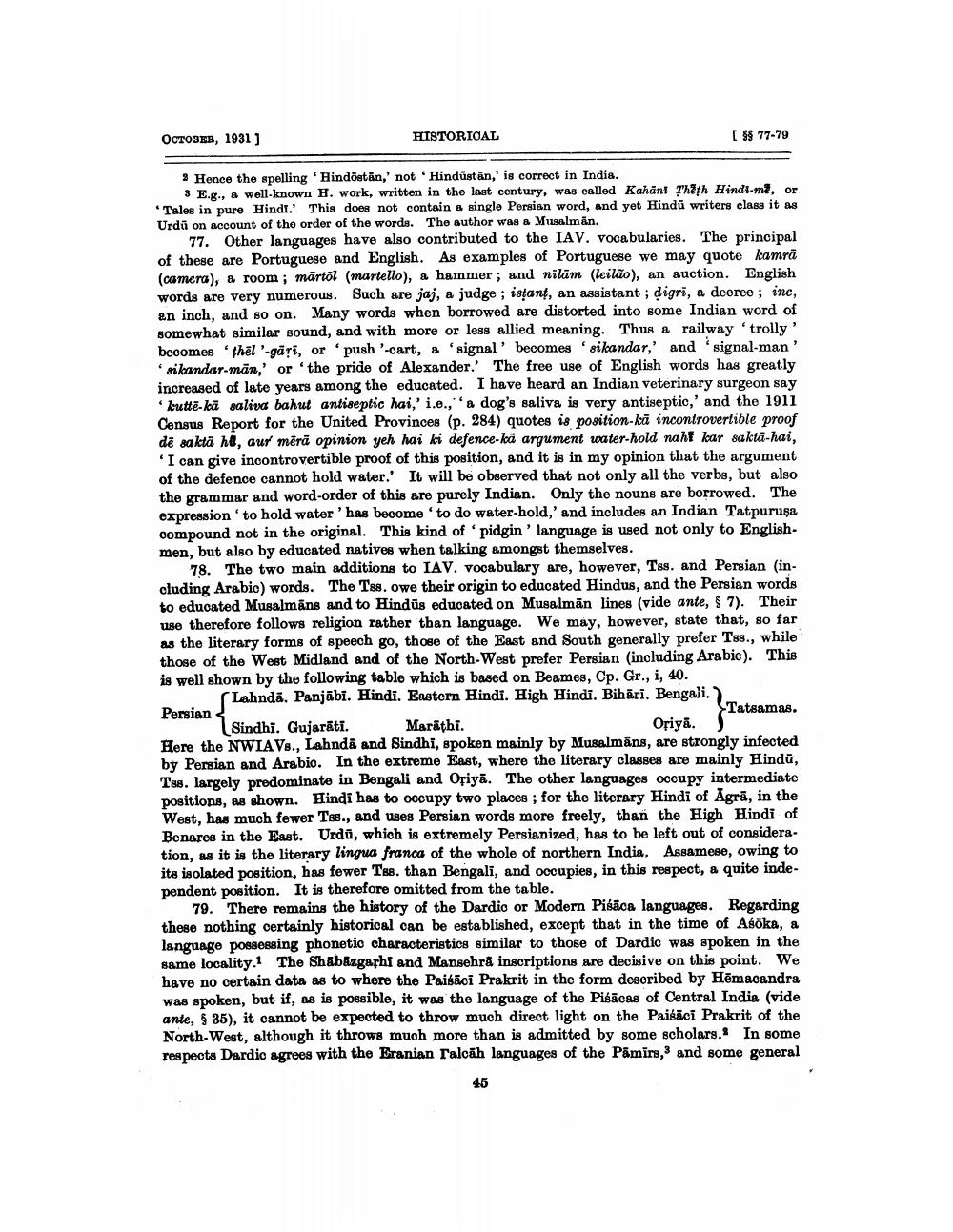________________
OCTOBER, 1931)
HISTORICAL
[ $ 77-79
9 Hence the spelling Hindõstān,' not Hindustan,' is correct in India.
8 E.8., & well-known H. work, written in the last century, was called Kahant Theth Hindi-m2, or * Tales in pure Hindt.' This does not contain a single Persian word, and yet Hindū writers class it as Urdū on account of the order of the words. The author was a Musalman.
77. Other languages have also contributed to the IAV. vocabularies. The principal of these are Portuguese and English. As examples of Portuguese we may quote kamra (camera), a room; märtöl (martello), a hainmer; and nilām (leilão), an auction. English words are very numerous. Such are jaj, a judge; istant, an assistant ; digri, a decree; inc, an inch, and so on. Many words when borrowed are distorted into some Indian word of somewhat similar sound, and with more or less allied meaning. Thus a railway trolly' becomes thel'-gäsi, or push '-cart, a 'signal' becomes 'sikandar,' and 'signal-man'
sikandar-man,' or 'the pride of Alexander.' The free use of English words has greatly increased of late years among the educated. I have heard an Indian veterinary surgeon say
kutte-kā saliva bahut antiseptic hai,' i.e.,' a dog's saliva is very antiseptic,' and the 1911 Census Report for the United Provinces (p. 284) quotes is position-kü incontrovertible proof de saktā he, aur mērā opinion yeh hai ki defence-kä argument water-hold nahi kar saktā-hai, 'I can give incontrovertible proof of this position, and it is in my opinion that the argument of the defence cannot hold water. It will be observed that not only all the verbs, but also the grammar and word-order of this are purely Indian. Only the nouns are borrowed. The expression' to hold water 'has become 'to do water-hold,' and includes an Indian Tatpuruşa compound not in the original. This kind of pidgin ' language is used not only to Englishmen, but also by educated natives when talking amongst themselves.
78. The two main additions to IAV. vocabulary are, however, Tss. and Persian (including Arabic) words. The Tss. owe their origin to educated Hindus, and the Persian words to educated Musalmans and to Hindūs educated on Musalmān lines (vide ante, $ 7). Their use therefore follows religion rather than language. We may, however, state that, so far as the literary forms of speech go, those of the East and South generally prefer Tss., while those of the West Midland and of the North-West prefer Persian (including Arabic). This is well shown by the following table which is based on Beames, Op. Gr., i, 40.
Lahndā. Panjabi. Hindi. Eastern Hindi. High Hindi. Bihari. Bengali, Sindhi. Gujarāti. Marathi.
Oriya. Here the NWIAVs., Lahndā and Sindhi, spoken mainly by Musalmāns, are strongly infected by Persian and Arabio. In the extreme East, where the literary classes are mainly Hindu, Tss. largely predominate in Bengali and Oțiyā. The other languages occupy intermediate positions, as shown. Hindi has to oocupy two places; for the literary Hindi of Agrā, in the West, has much fewer Tas., and uses Persian words more freely, than the High Hindi of Benares in the East. Urdū, which is extremely Persianized, has to be left out of consideration, as it is the literary lingua franca of the whole of northern India, Assamese, owing to its isolated position, has fewer Tss. than Bengali, and occupies, in this respect, a quite independent position. It is therefore omitted from the table.
79. There remains the history of the Dardic or Modern Pisāca languages. Regarding these nothing certainly historical can be established, except that in the time of Asoka, a language possessing phonetic characteristics similar to those of Dardic was apoken in the same locality.1 The Shābāzgashi and Mansehrā inscriptions are decisive on this point. We have no certain data as to where the Paisāci Prakrit in the form described by Hēmacandra was spoken, but if, as is possible, it was the language of the Pisācas of Central India (vide ante, 635), it cannot be expected to throw much direct light on the Paigāci Prakrit of the North-West, although it throws much more than is admitted by some scholars. In some respects Dardio agrees with the Eranian Calcāh languages of the Pamirs,' and some general
Persian
Tatsamas.
45




